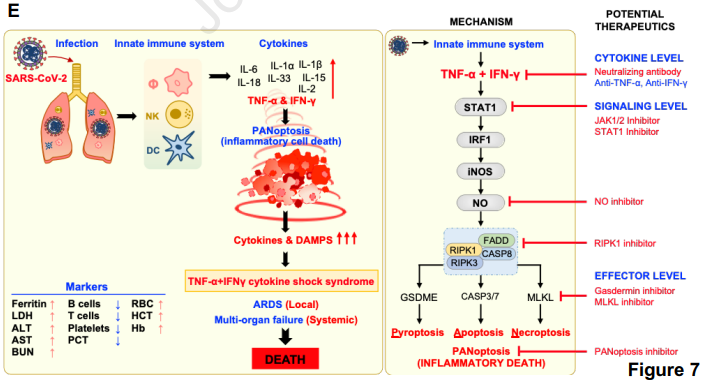The COVID-19 pandemic continues to cause major illness and death, while treatment options are still limited. In a new study, researchers from the St. Jude Children’s Research Hospital in the United States have discovered a potential strategy to prevent life-threatening inflammation, lung damage, and organ failure in COVID-19 patients. The relevant research results were published in the Cell. The title of the paper is “Synergism of TNF-α and IFN-γ triggers inflammatory cell death, tissue damage, and mortality in SARS-CoV-2 infection and cytokine shock syndromes”.
These authors identified drug candidates after discovering that the excessive inflammatory immune response associated with COVID-19 triggered tissue damage and multiple organ failure in mice by triggering the inflammatory cell death pathway. They detailed how the inflammatory cell death signaling pathway works to help develop potential treatments to disrupt this process.
Dr. Thirumala-Devi Kanneganti, the corresponding author of the paper, said, “Understanding the pathways and mechanisms that drive this inflammation is critical to developing effective treatment strategies. This research provides this understanding. We have also identified specific cytokines that activate inflammatory cell death pathways, which have considerable potential in the treatment of COVID-19 and other highly fatal diseases including sepsis.”
COVID-19, cytokines and inflammatory cell death
COVID-19 is caused by the SARS-CoV-2 coronavirus. In less than a year, this virus infection has caused more than 1.2 million deaths and millions more have become ill.
This viral infection is characterized by elevated levels of various cytokines in the blood. These small molecular proteins are mainly secreted by immune cells to ensure a rapid response that limits the virus. Some cytokines can also cause inflammation.
The phrase cytokine storm is used to describe the sharp increase in blood cytokine levels and other immune changes, which can also be observed in inflammatory diseases such as COVID-19, sepsis, and hematopoietic lymphohistiocytosis (HLH). However, in COVID-19 and other diseases, the specific pathways that initiate the cytokine storm and subsequent inflammation, lung injury, and organ failure are still unclear. It also lacks a comprehensive determination of the cellular and molecular mechanisms of cytokine storms.
Kanneganti’s research team focused on a selection of the most elevated cytokines in COVID-19 patients. They found that none of the cytokines can induce the death of innate immune cells.
These authors then tried 28 combinations of cytokines and found that only the combination of two cytokines induced a form of inflammatory cell death previously described by Kanneganti, namely PANoptosis. The two cytokines are tumor necrosis factor-alpha (TNF-α) and interferon-gamma (IFN-γ). PANoptosis is a unique type of cell death, which is characterized by the coordination of three different cell death pathways – pyroptosis, apoptosis, and necroptosis. PANoptosis triggers inflammation through cell death, which leads to the release of more cytokines and inflammatory molecules.
These authors found that blocking a single cell death pathway is not effective in preventing cell death caused by TNF-α and IFN-γ. By carefully observing the proteins that make up these pathways, they found that several proteins including caspase-8 and STAT1 are necessary for PANoptosis to respond to these cytokines. Removing these proteins can block PANoptosis in innate immune cells called macrophages.

Reusing the potential of TNF-α and IFN-γ blockers to treat COVID-19
Given that TNF-α and IFN-γ are produced during COVID-19 and cause the death of inflammatory cells, these authors question whether these cytokines are responsible for the clinical manifestations and fatal effects of the disease. They found that the combination of TNF-α and IFN-γ caused tissue damage and inflammation, which were similar to the symptoms of COVID-19, accompanied by rapid death.
At present, in clinical practice, neutralizing antibodies against TNF-α and IFN-γ are used to treat inflammatory diseases. The authors found that treatment with these antibodies can protect mice from deaths associated with SARS-CoV-2 infection, sepsis, HLH, and cytokine shock.
Kanneganti said, “These findings link TNF-α and IFN-γ-induced inflammatory cell death to COVID-19. These results also indicate that therapies for this combination of cytokines may not only target COVID-19 but also candidates for several other deadly diseases associated with cytokine storms.”
The first author of the paper Dr. Rajendra Karki added, “We are excited to connect these dots to understand how TNF-α and IFN-γ trigger PANoptosis. In fact, to understand how PANoptosis causes disease and death is essential to determine the treatment.”
Redefining the cytokine storm
Based on this basic research, Kanneganti and her colleagues proposed the definition of cytokine storm, placing cytokine-mediated inflammatory cell death through PANoptosis at the center of this process. These authors pointed out that PANoptosis will lead to the release of more cytokines and inflammatory molecules, thereby exacerbating systemic inflammation.
Kanneganti said, “By identifying the key factors responsible for initiating this process, we have solved an important link in the mystery of the cytokine storm and identified a unique combination therapy that uses existing drugs. These drugs have been used clinically.”
Reference
Rajendra Karki et al. Synergism of TNF-α and IFN-γ triggers inflammatory cell death, tissue damage, and mortality in SARS-CoV-2 infection and cytokine shock syndromes. Cell, 2020, doi:10.1016/j.cell.2020.11.025.